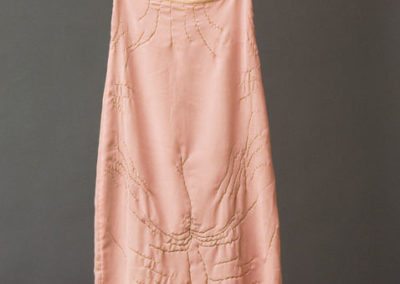Lines and Threads
Lines and Threads
The Art of Stitching – International Contemporary Embroidery
„As the Sewing Thread Circles the Button”
In Antiquity, embroidery was referred to as „painting with a needle”. With the subtle use of the embroidery thread, which necessitates lots of patience and close attention to detail, they meant to strive for the same recognition as the painters who worked with brushes that were easier to handle. Then came the meticulous orderliness of the old sewing boxes, from which threads, needles, and yarns soon escaped once again, and took a completely new direction, compared to previous centuries. Embroidery and stitching no longer brings back the atmosphere of the biedermeier interior, as women’s busy hands don’t embroider delicate garments and knit stockings next to the fireplace. The precise structure of contours into which the threads were constrained has frayed and come undone. Nowadays, when this technique is used not only by women but by men also, the gesture of embroidery and handcraft is much less specific and points in various directions.
Textile art, and within it the genre of embroidery, went through great changes in both the materials and the technique used. The different experiments with the material, the frequency of medium change, as well as technical variety are all characteristic of the recent history of textile art. The young generation of artists of the 1960’s and 70’s reinterpreted the genre. This is when sewing and embroidery as a technique rises to the level of high art, creating a large number of emblematic works. The process seems irreversible, as textile is livelier than ever. The two exhibitions held on the first floor of the Museum of Applied Arts (The Art of Stitching, “As the Sewing Thread Circles the Button”) give a taste of this, as well as show the numerous possibilities inherent in the genre.
In the Hungarian section, each generation creatively uses the traditional technique of embroidery; however, their designs differ widely. The young generation ironically questions the embroidery frame and puts it in quotation marks. This is both a homage to the old and a paraphrase of it…
Györgyi Kapala uses her own body prints as a basis for her work. CT images of her brain, her fingerprints as well as her iris are represented in the form of tapestry. Luca Gőbölyös’s work Fresh as a Flower is similar to this in that it urges us to think, through sensuality, of idolized female beauty, as well as of questions of ageing and passing away……
Katalin Izinger
Revised, shortened version.
Published: Artmagazin, 2009/1.
So Many Miss Marple
So Many Miss Marple
The Art of Stitching – International Contemporary Embroidery
“As the Sewing Thread Circles the Button”
The reason that Laura Somogyi’s work is not the strongest memory is because of Luca Gőbölyös. It was her pink slip on a hanger that I first passed by without paying much attention. If it’s a slip, oh well, we don’t always need to understand how certain exhibition objects got selected. This, however, was indeed well selected, as the slip is covered with stitches, the image of an old woman’s body, with a hanging belly, breasts disfigured by long wrinkles, sagging thighs. Old age has been sewn into the old garment. Old age, from which we usually shudder when seeing it on a photograph, an aversion which Luca Gőbölyös does not deny. “Fresh as a Flower” is the slogan of the laundry, and of course, it’s about as fresh as a three week old rose, but still, there is so much tenderness in it that the feared word suddenly becomes our common story, as we grow old together with Dad, Mom, Zsuzsa Cserháti. And Luca Gőbölyös.
Miklós Fáy
Revised, shortened version.
Published: Artmagazin , 2009/1.


